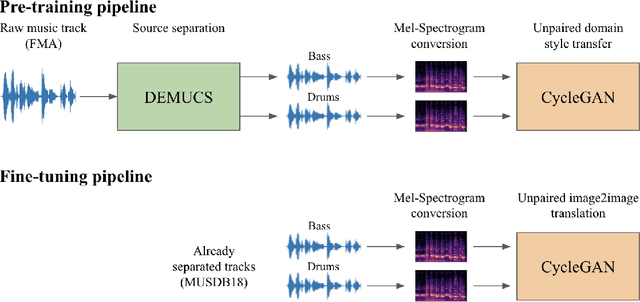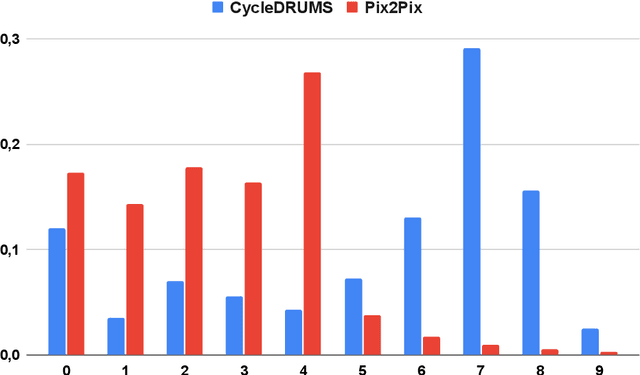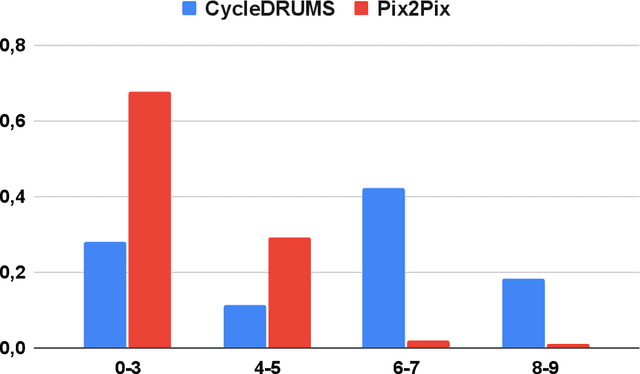Giorgio Barnabò
CycleDRUMS: Automatic Drum Arrangement For Bass Lines Using CycleGAN
Apr 09, 2021



Abstract:The two main research threads in computer-based music generation are: the construction of autonomous music-making systems, and the design of computer-based environments to assist musicians. In the symbolic domain, the key problem of automatically arranging a piece music was extensively studied, while relatively fewer systems tackled this challenge in the audio domain. In this contribution, we propose CycleDRUMS, a novel method for generating drums given a bass line. After converting the waveform of the bass into a mel-spectrogram, we are able to automatically generate original drums that follow the beat, sound credible and can be directly mixed with the input bass. We formulated this task as an unpaired image-to-image translation problem, and we addressed it with CycleGAN, a well-established unsupervised style transfer framework, originally designed for treating images. The choice to deploy raw audio and mel-spectrograms enabled us to better represent how humans perceive music, and to potentially draw sounds for new arrangements from the vast collection of music recordings accumulated in the last century. In absence of an objective way of evaluating the output of both generative adversarial networks and music generative systems, we further defined a possible metric for the proposed task, partially based on human (and expert) judgement. Finally, as a comparison, we replicated our results with Pix2Pix, a paired image-to-image translation network, and we showed that our approach outperforms it.
Algorithms for Fair Team Formation in Online Labour Marketplaces
Feb 14, 2020



Abstract:As freelancing work keeps on growing almost everywhere due to a sharp decrease in communication costs and to the widespread of Internet-based labour marketplaces (e.g., guru.com, feelancer.com, mturk.com, upwork.com), many researchers and practitioners have started exploring the benefits of outsourcing and crowdsourcing. Since employers often use these platforms to find a group of workers to complete a specific task, researchers have focused their efforts on the study of team formation and matching algorithms and on the design of effective incentive schemes. Nevertheless, just recently, several concerns have been raised on possibly unfair biases introduced through the algorithms used to carry out these selection and matching procedures. For this reason, researchers have started studying the fairness of algorithms related to these online marketplaces, looking for intelligent ways to overcome the algorithmic bias that frequently arises. Broadly speaking, the aim is to guarantee that, for example, the process of hiring workers through the use of machine learning and algorithmic data analysis tools does not discriminate, even unintentionally, on grounds of nationality or gender. In this short paper, we define the Fair Team Formation problem in the following way: given an online labour marketplace where each worker possesses one or more skills, and where all workers are divided into two or more not overlapping classes (for examples, men and women), we want to design an algorithm that is able to find a team with all the skills needed to complete a given task, and that has the same number of people from all classes. We provide inapproximability results for the Fair Team Formation problem together with four algorithms for the problem itself. We also tested the effectiveness of our algorithmic solutions by performing experiments using real data from an online labor marketplace.
* Accepted at "FATES 2019 : 1st Workshop on Fairness, Accountability, Transparency, Ethics, and Society on the Web" (http://fates19.isti.cnr.it)
 Add to Chrome
Add to Chrome Add to Firefox
Add to Firefox Add to Edge
Add to Edge